The Glasgow and Inveraray Steamboat Company operated a popular service to the Kyles of Bute, using two fine paddle steamers both named Lord of the Isles. The first was built in 1877. It was replaced by the second Lord in 1891 – which was well known on the river until it was broken up in 1928. Today, only the Waverley remains of the once-great fleet of paddle steamers which sailed along the Clyde.
Prints and text about The Lord of the Isles.
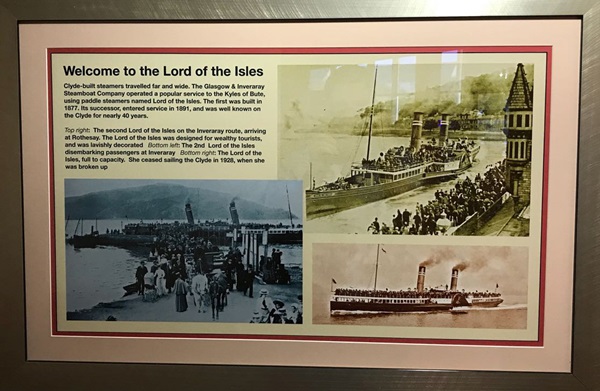
The text reads: Clyde-built steamers travelled far and wide. The Glasgow & Inveraray Steamboat Company operated a popular service to the Kyles of Bute, using paddle steamers named Lord of the Isles. The first was built in 1877. Its successor, entered service in 1891, and was well known on the Clyde for nearly 40 years.
Top right: The Second Lord of the Isles on the Inveraray route, arriving at Rothesay. The Lord of the Isles was designed for wealthy tourists, and was lavishly decorated.
Bottom left: the second Lord of the Isles disembarking passengers at Inveraray
Bottom right: The Lord of the Isles, full to capacity. She ceased sailing the Clyde in 1928, when she was broken up.
A photograph of the biggest and best British battlecruiser, HMS Hood, leaving Clydebank in 1920.
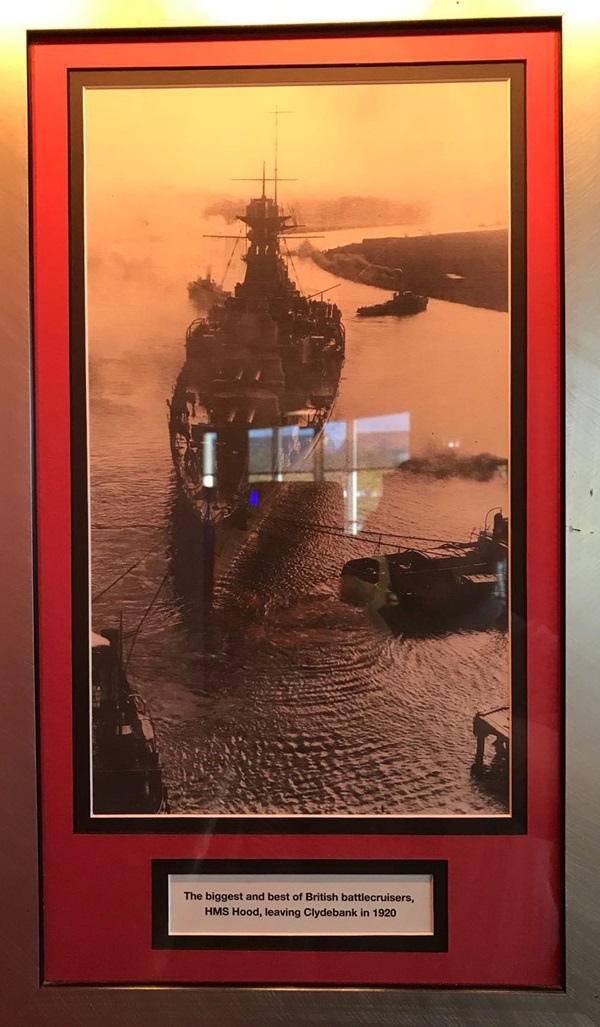
Prints and text about ships and shipping.
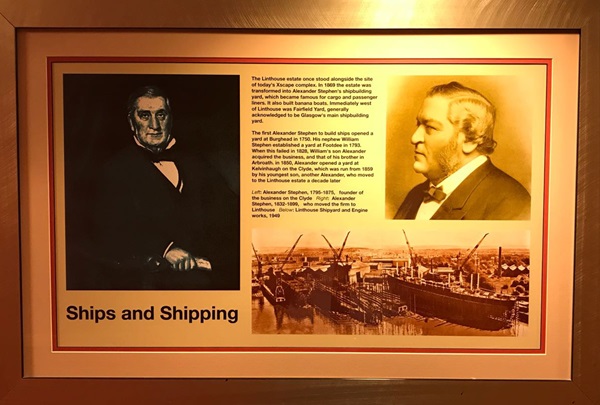
The text reads: The Linthouse estate once stood alongside the site of today’s Xscape complex. In 1869 the estate was transformed into Alexander Stephen’s ship-building yard, which became famous for cargo and passenger liners. It also built banana boats. Immediately west of Linthouse was Fairfield Yard, generally acknowledged to be Glasgow’s main ship-building yard.
The first Alexander Stephen to build ships opened a yard at Burghead in 1750. His nephew William Stephen established a yard at Footdee in 1793. When this failed in 1828, William’s son Alexander acquired the business, and that of his brother in Arbroath. In 1850, Alexander opened a yard at Kelvinhaugh on the Clyde, which was run from 1859 by his youngest son, another Alexander, who moved to the Linthouse estate a decade later.
Left: Alexander Stephen, 1795-1875, founder of the business on the Clyde
Right: Alexander Stephen, 1832-99, who moved the firm to Linthouse
Below: Linthouse Shipyard and engine works, 1949.
Prints and text about the Clyde.
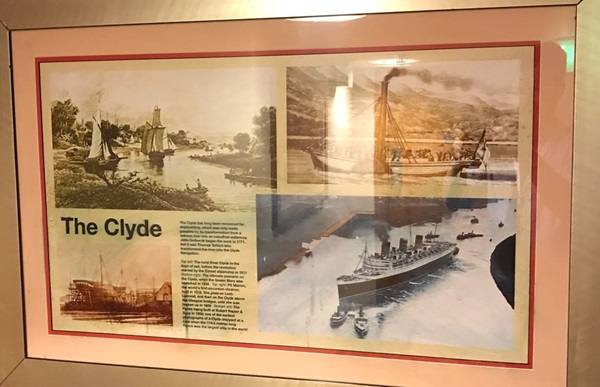
The text reads: The Clyde has long been renowned for ship-building, which was only made possible by its transformation from a salmon river into an industrial waterway. John Golborne began the work in 1771, but it was Thomas Telford who transformed the river into the Clyde Navigation.
Top left: The rural River Clyde in the days of sail, before the revolution started by the Comet steamship in 1811
Bottom right: The ultimate scenario on the Clyde, when the Queen Mary was launched in 1934
Top right: PS Marion, the world’s first excursion steamer, built in 1816. She plied on Loch Lomond, and then on the Clyde above the Glasgow bridges, until she was broken up in 1828
Bottom left: The Persia being built at Robert Napier & Sons in 1855; one of the earliest photographs of a Clyde shipyard at a time when the 114.5 meters long Persia was the largest ship in the world.
Prints and text about John Elder.
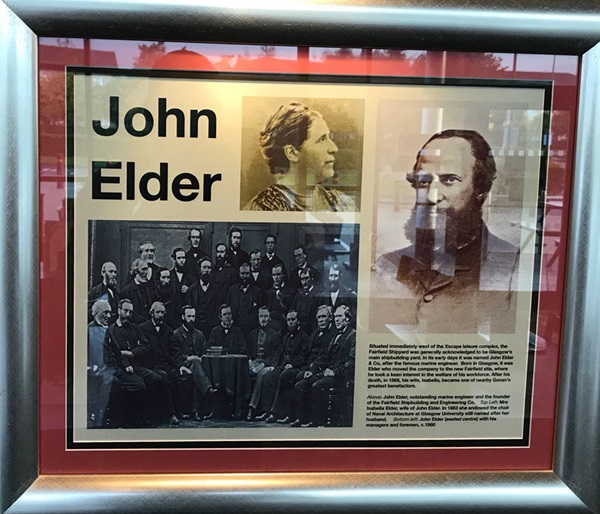
The text reads: Situated immediately west of the Xscape leisure complex, the Fairfield Shipyard was generally acknowledged to be Glasgow’s main shipbuilding yard. In its early days it was named John Elder & C, after the famous marine engineer. Born in Glasgow, it was Elder who moved the company to the new Fairfield site, where he took a keen interest in the welfare of his workforce. After his death, in 1869, his wife, Isabella, became one of the nearby Govan’s greatest benefactors.
Above: John Elder, outstanding marine engineer and the founder of the Fairfield Shipbuilding and Engineering Co
Top left: Mrs Isabella Elder, wife of John Elder. In 1883 she endowed the chair of Naval Architecture at Glasgow University still named after her husband
Bottom left: John Elder (seated centre) with his managers and foremen, c1860.
A print, illustrations and text about the Comet.
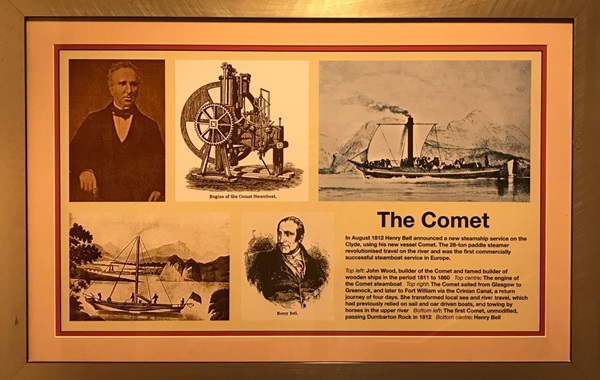
The text reads: In August 1812 Henry Bell announced a new steamship service on the Clyde, using his new vessel Comet. The 28-ton paddle steamer revolutionised travel on the river and was the first commercially successful steamboat service in Europe.
Top left: John Wood, builder of the Comet and famed builder of wooden ships in the period 1811 to 1860
Top centre: The engine of the Comet steamboat
Top right: The Comet sailed from Glasgow to Greenock, and later to Fort William via the Crinian Canal, a return journey of four days. She transformed local sea and river travel, which had previously relied on sail and oar driven boats, and towing by horses in the upper river
Bottom left: The first Comet, unmodified, passing Dumbarton Rock in 1812
Bottom centre: Henry Bell.
Photographs and text about Lobnitz and William Simons.
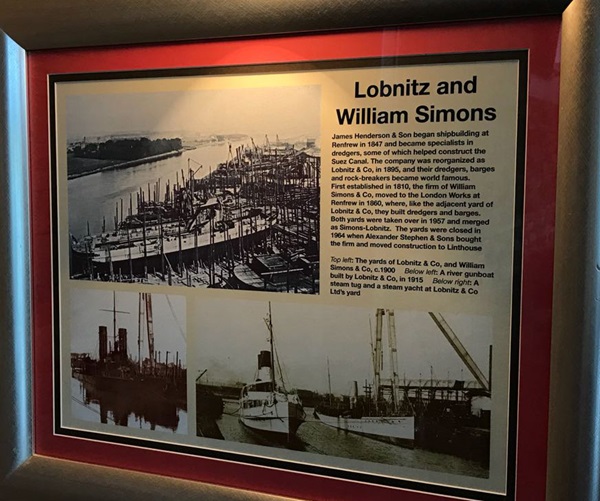
The text reads: James Henderson & Sons began ship-building at Renfrew in 1847 and became specialists in dredgers, some of which helped construct the Suez Canal. The company was reorganised as Lobnitz & Co, in 1895, and their dredgers, barges and rock-breakers became world famous. First established in 1810, the firm of William Simons & Co, moved to the London Works at Renfrew in 1860, where, like the adjacent yard of Lobnitz & Co, they built dredgers and barges. Both yards were taken over in 1957 and merged as Simons-Lobnitz. The yards were closed in 1964 when Alexander Stephen & Sons bought the firm and moved construction to Linthouse.
Top left: The yards of Lobnitz & Co, and William Simons & Co, c1900
Below left: A river gunboat built by Lobnitz & Co, in 1915
Below right: A steam tug and a steam yacht at Lobnitz & Co Ltd’s yard.
Photographs and text about Renfrew Airport.
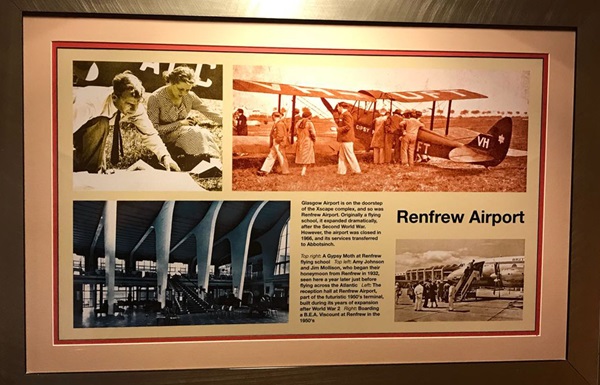
The text reads: Glasgow Airport is on the doorstep of the Xscape complex, and so was Renfrew Airport. Originally a flying school, it expanded dramatically after the Second World War. However, the airport was closed in 1966, and its services transferred to Abbotsinch.
Top right: A Gypsy Moth at Renfrew flying school
Top left: Amy Johnson and Jim Mollison, who began their honeymoon from Renfrew in 1932, seen here a year later just before flying across the Atlantic
Left: The reception hall at Renfrew Airport, part of the futuristic 1950s terminal, built during its years of expansion after World War II
Right: Boarding a BEA Viscount at Renfrew in the 1950s.
Photographs and text about Fairfield.
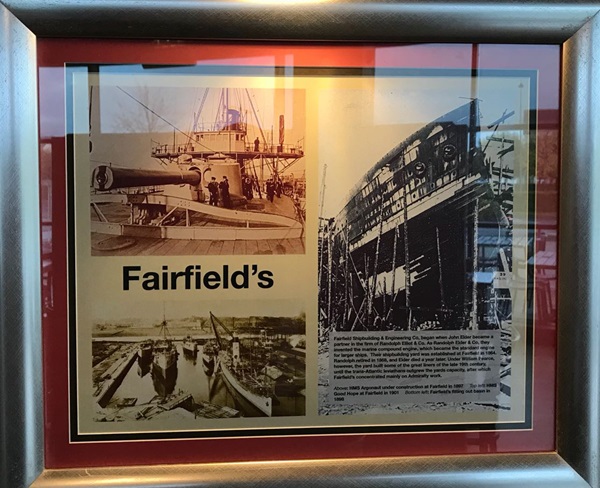
The text reads: Fairfield Ship-building & Engineering Co, began when John Elder became a partner in the firm of Randolph Elliot & Co. As Randolph Elder & Co, they invented the marine compound engine, which became the standard engine for larger ships. Their ship-building yard was established at Fairfield in 1864. Randolph retired in 1868, and Elder died a year later. Under William Pearce, however, the yard built some of the greatest liners of the late 19th century, until the trans-Atlantic leviathans outgrew the yards capacity, after which Fairfield’s concatenated mainly on Admiralty work.
Above: HMS Argonaut under construction at Fairfield in 1897
Top left: HMS Good Hope at Fairfield in 1901
Bottom left: Fairfield’s fitting out basin in 1898.
A sculpture entitled Interlocking Curves, by Frances Priest.
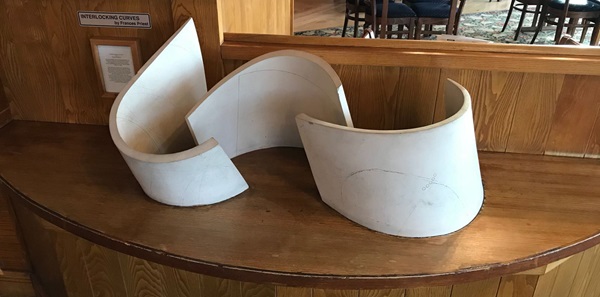
Frances Priest was commissioned to produce this sculpture reflecting the forms of waves and of ship’s hulls, representative of the nearby River Clyde.
The ceramic forms may reference the recognisable but exist in their own right as significant physical statements. Surfaces are embedded and inlayed, layered with marks and patterns that act as punctuation and direct the viewer’s attention in and around the forms sources for the patterns, surfaces, and marks are diverse adding layers of meaning to the physical layers of the object.
External photograph of the building – main entrance.
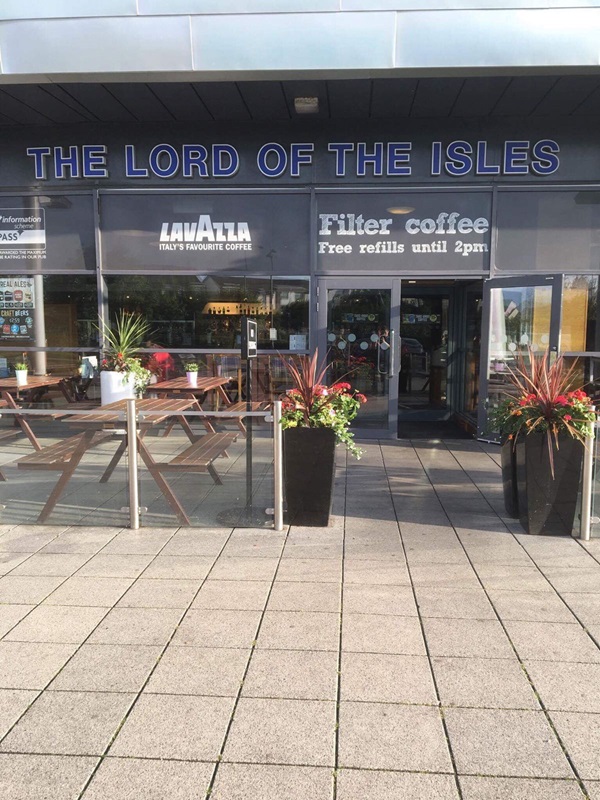
If you have information on the history of this pub, then we’d like you to share it with us. Please e-mail all information to: pubhistories@jdwetherspoon.co.uk